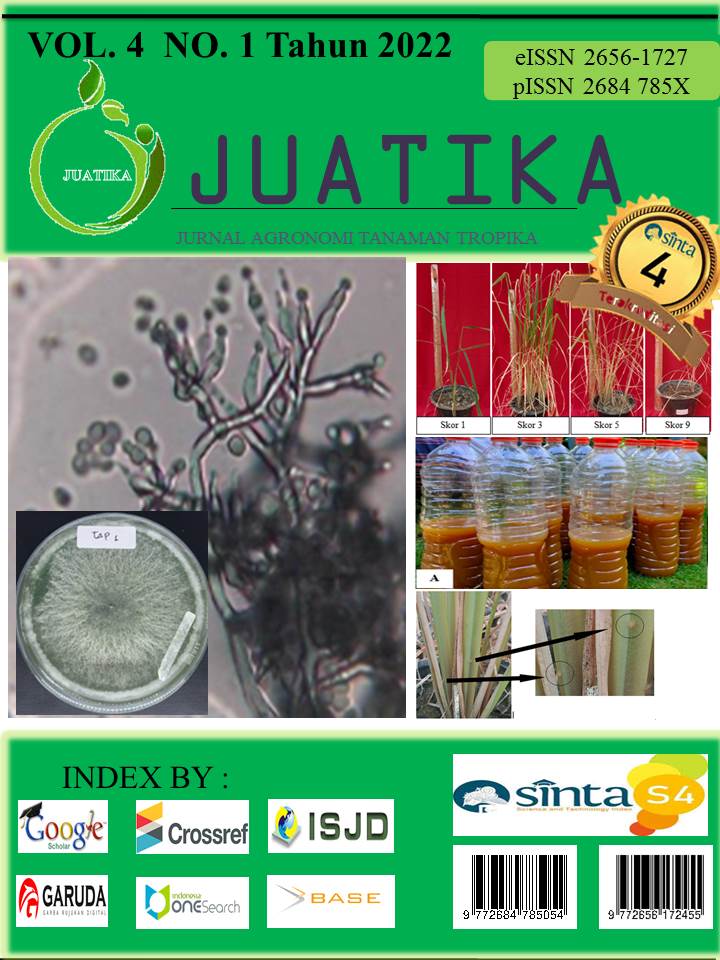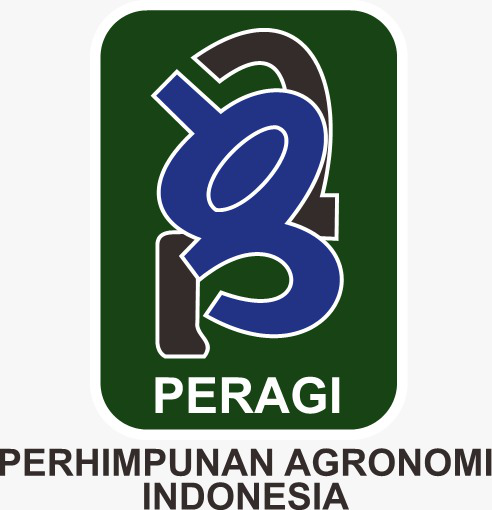A Land Productivity Of The Intercropping Shallot (Allium Ascalonicum L) And Chili Pepper (Capsicum Frutescens L) With Liquid Organic Fertilizer And Solid Organic Fertilizer
Abstract
Shallot and cayenne pepper are two national superior commodities that must continue to be cultivated in order to meet the daily needs of the community. The purpose of the study was to determine the land productivity of the shallot and cayenne pepper intercropping system with POC Biological and Solid treatment. This research was carried out at the Experimental Farm of the Faculty of Agriculture, Islamic University of Riau for 6 months, starting from October 2020 to March 2021. The study used a completely randomized design with 2 factorials, the first was the dose of Solid fertilizer with 4 treatment levels, namely 0 tons/ha, 5 tons /ha, 10 tons/ha, 15 tons/ha and the second is the concentration of Biological POC with 5 treatment levels, namely 0 ml/l water, 2 ml/l water, 4 ml/l water, 6 ml/l water, 8 ml/ l water. Parameters observed in shallot plants were plant height, number of tubers per clump, wet bulb weight per plant, dry bulb weight per plant, and in cayenne pepper plants were plant height, number of fruits per plant and fruit weight per plant. Observational data were analyzed statistically and continued with the further BNJ test at the 5% level. The results showed that the Solid and POC hayati treatment in shallots had a significant effect, with the best treatment being 4 ml/l water and 10 tons/ha. Meanwhile, the cayenne pepper plant has no effect except for plant height.
Downloads
References
Badan Pusat Statisti. 2021. Produksi Tanaman Sayuran 2020. Bps.go.id. https:// www.bps.go.id/indicator/55/61/1/produksi-tanaman-sayuran.html. diakses 11 September 2021.
Anisyah, F., Sipayung, R., & Hanum, C. (2014). Pertumbuhan Dan Produksi Bawang Merah Dengan Pemberian Berbagai Pupuk Organik. Jurnal Agroekoteknologi Universitas Sumatera Utara, 2(2), 482–496. https://doi.org/10.32734/jaet.v2i2.7051
Despita, R., Nizar, A., Purnomo, D., & Fernanda, Y. (2020). Produksi Bawang Merah Tumpangsari Dengan Cabai Pada Beberapa Jarak Tanam Production of Shallot on Intercroping With Chili At Multiple Planting Spacing. | Jurnal Agriekstensia, 19(2), 172–180. https://repository.polbangtanmalang.ac.id/xmlui/handle/123456789/634%0Ahttps://repository. polbangtanmalang.ac.id/xmlui/bitstream/handle/123456789/634/Produksi Bawang Merah.pdf?sequence=1
Gultom, F., Ezward, C., & Seprido. (2019). Pemberian Pupuk Kompos Solid Plus ( Kos Plus ) dan Pupuk NPK Mutiara 16 : 16 : 16 terhadap Pertumbuhan dan Produksi Cabai Merah ( Capsicum annum L .). Seminar Nasional Pembangunan Pertanian Dan Pedesaan, 1, 210–219.
Idaryani, & Warda. (2018). Kajian Pemanfaatan Pupuk Organik Cair Untuk Meningkatkan Hasil Tanaman Cabai. Biocelebes, 12(3), 87–105.
Uke, K.H.Y., Barus, H& Madauna, I.S. (2015). Pengaruh Ukuran Umbi dan Dosis Kalium Terhadap Pertumbuhan dan Hasil Produksi Bawang Merah (Allium ascalonicum L.) Varietas Lembah Palu. E-J. Agrotekbis, 3(6), 655–661.
Tarigan, P.A., Armaini, & Murniati. (2017). Pengaruh Beberapa Dosis Limbah Padat Pabrik Kelapa Sawit (Sludge) dan Pupuk P Terhadap Pertumbuhan dan Produksi Tanamanbawang Merah (Allium ascalonicum L.). JOM FAPERTA, 4(1), 1–14.
Purba, J. H., Wahyuni, P. S., Zulkarnaen, Z., Sasmita, N., Yuniti, I. G. A. D., & Pandawani, N. P. (2020). Growth and yield response of shallot (Allium ascalonicum L. var. Tuktuk) from different source materials applied with liquid biofertilizers. Nusantara Bioscience, 12(2), 127–133. https://doi.org/10.13057/nusbiosci/n120207
Baharuddin, R & Sutriana, S. (2019). Pertumbuhan dan Produksi Tanaman Tumpangsari Cabai Dengan Bawang Merah Melalui Pengaturan Jarak Tanam dan Pemupukan NPK Pada Tanah Gambut. Jurnal Dinamika Pertanian, 3, 73–80.
Sumarni, N., Rosliani, R., Basuki, R. ., & Hilman, Y. (2012). Pengaruh Varietas, Status K-Tanah, dan Dosis Pupuk Kalium terhadap Pertumbuhan, Hasil Umbi, dan Serapan Hara K Tanaman Bawang Merah. Jurnal Hortikultura, 22(3), 233–241. https://doi.org/10.21082/jhort.v22n3.2012.p233-241
Suprapto, A., Astiningrum, M., & Rianto, H. (2019). Optimalisasi Jarak Tanam Dan Pupuk Organik Cair Untuk Produksi Tumpangsari Bawang Merah Dan Cabai Merah Di Lahan Pasca …. The 9th University Research Colloqium. http://eproceedings.umpwr.ac.id/index.php/urecol9/article/view/554
Suryawaty, & Hafiz, F. (2015). Pengaruhpupuk Organik Cair dan Limbah Padat (Sludge) Terhadap Pertumbuhan Dan Produksi Tanaman Tomat (Solanum lycopersicum L.). Agrium, 19(2), 122–129.
Tuhuteru, S., Inrianti, Maulidiyah, & Nurdin, M. (2020). Pemanfaatan Pupuk Organik Cair Nasa dalam Meningkatkan Produktivitas Bawang Merah di Daerah Wamena. Agroteknika, 3(2), 85–98. https://doi.org/10.32530/agroteknika.v3i2.78
Hidayatullah, W., T. Rosmawaty, & M. Nur. (2020). Pengaruh Pemberian Pupuk Kascing Dan NPK Mutiara 16:16:16 Terhadap Pertumbuhan dan Hasil Okra (Abelmoschus esculentus (L.) Moenc.) Serta Bawang Merah (Allium ascalonicum L.) Dengan Sistem Tumpang Sari. Dinamika Pertanian, 36(1), 11–20. https://doi.org/10.25299/dp.2020.vol36(1).5363
Pranoto, Y.A., Ezward, C & Wahyudi. (2020). Uji Konsentrasi POC Diamond Interest Grow Terhadap Pertumbuhan dan Produksi Cabai Merah Keriting (Capsicum annum L.). Jurnal Green Swarnadwipa, 9(1), 118–126.
Copyright (c) 2022 Selvia - Sutriana, Saripah Ulpah, Raisa Baharuddin

This work is licensed under a Creative Commons Attribution 4.0 International License.
Authors who publish with Jurnal Agronomi Tanaman Tropika (JUATIKA) agree to the following terms:
Authors retain copyright and grant the Jurnal Agronomi Tanaman Tropika (JUATIKA) right of first publication with the work simultaneously licensed under a Creative Commons Attribution License (CC BY 4.0) that allows others to share (copy and redistribute the material in any medium or format) and adapt (remix, transform, and build upon the material for any purpose, even commercially) with an acknowledgment of the work's authorship and initial publication in Jurnal Agronomi Tanaman Tropika (JUATIKA).
Authors are able to enter into separate, additional contractual arrangements for the non-exclusive distribution of the journal's published version of the work (e.g., post it to an institutional repository or publish it in a book), with an acknowledgment of its initial publication in Jurnal Agronomi Tanaman Tropika (JUATIKA). Authors are permitted and encouraged to post their work online (e.g., in institutional repositories or on their website) prior to and during the submission process, as it can lead to productive exchanges, as well as earlier and greater citation of published work.







 More Information
More Information



